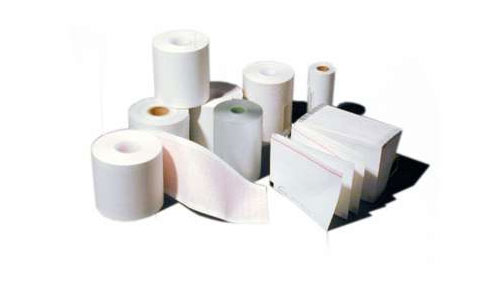Fine chemicals for thermal recording paper
Thermal recording paper usually refers to leuco dye thermal recording paper, which is composed of base paper and thermal coatings.

Color former, developer, sensitizer
Various fine chemicals are used in the thermal coatings, the main chemicals are thermosensitive dyes, color formers, developers, sensitizers and stabilizers. They are dispersed in a solution containing water-soluble adhesives to form a suspension of particles below 2μm, then added with dispersant/anti-flocculant, uv absorbent, whitening agent and other additives, coated on the surface of the base paper. After drying, thermal recording paper is obtained. When the hot-head of the fax machine is printed, the heated part of the thermosensitive dye, color developer and sensitizer immediately melt and mix and color, to obtain a record portrait.
Color former
Color former used in thermal paper is a leuco dye, which is colorless at room temperature. Leuco dyes undergo a structural change when protonated in the presence of heat and a proton donor (developer). The structural change results in the production of color.
The main color formers used in industry are triarylmethane phthalide and fluorane compounds. Among them, fluorane dyes are the mainstream of thermo-sensitive dyes developed in today’s world, accounting for 2/3 of the thermo-sensitive dyes.
Color former used in thermal recording papers should have the following characteristics.
- color former usually is white or off-white powder, and does not react with developers under high humidity.
- high sensitivity, good coloration and image stability.
- the heat-sensitive paper has high whiteness and good stability for recording image.
- stable quality, easy to manufacture, low cost.
The main thermal dyes are ODB-1, ODB-2, CVL, etc.
CAS 89331-94-2 ODB-2, CAS 1552-42-7 CVL
Developer
Developers are the chemicals that react with thermosensitive dyes. Developers are usually weakly acidic, transfer protons to the dye and trigger color formation. The main products are bisphenol A, bisphenol S and p-hydroxybenzoate etc.
Developers should meet following requirements.
- reaction at the temperature of the specific printer and ability to fully react with color former when heated.
- stable at end use temperatures.
- acidity such that it produces no background imaging.
- appropriate performance and feasible in large-scale production.
- it has high chromogenic speed, high chromogenic concentration, good sensitivity and good compatibility with colorless dyes.
- the chromogenic image has good ageing resistance, water resistance and plasticizer resistance.
- good whiteness, no yellowing of paper surface during preservation, no decline in hair color ability, moderate melting point, no sublimation.
- cheap, non-toxic, tasteless, well dispersed in water.
CAS 95235-30-6 D-8, CAS 80-09-1 BPS
Sensitizer
Sensitizer has a lower melting point, thus acting as a solvent, promoting the interaction of the developer with the dye. Sensitizers typically have a melting point between 45-65°C.
Sensitizers are usually neutral compounds with low viscosity in the melting point range. The sensitizers should have excellent cost effectiveness and can be used with most color former/developer systems. The addition of sensitizer can reduce the melting point of the color developing system and improve the color sensitivity of the thermosensitive recording paper. At present, thermal recording paper is developing in the direction of high sensitivity, high definition and high stability. It is necessary to add sensitizer in thermal recording paper to improve the color sensitivity, color concentration, stability and clarity of the picture.
